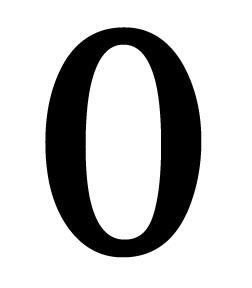
The Number System Glyph Evolution
I was reading about the modern number system (Wikipedia and answers), when I found the following interesting fact :All the numbers from 0-9 derive their current glyph icons from earlier Indian Style of representing Numbers.
As Wikipedia states, the origin of the 9 integers can be attributed to the ancient Indian civilization, and was adopted by subsequent civilizations in conjunction with the 0:
1. 0 (Zero) - We all know, that we all say, that Zero was invented in India. Maybe it was, maybe it wasn't, but the current glyph representation of the number Zero definitely comes from India.
2. 1 (One) - The glyph used today in the Western world to represent the number 1 traces its roots back to Indians who used to write it as a single horizontal line.

3. 2 (Two) - The glyph used in the modern Western world to represent the number 2 traces its roots back to the Brahmin Indians, who wrote "2" as two horizontal lines.

4. 3 (Three) - The Romans started writing the number 3 with three vertical lines, which they still do. This was the way the Brahmin Indians wrote it, but horizontally, and the Gupta made the three lines more curved.

5. 4 (Four) - Representing 1, 2 and 3 in as many lines as the number represented worked well. The Brahmin Indians simplified 4 by joining its four lines into a cross that looks like our modern plus sign.

6. 5 (Five) - The evolution of our modern glyph for five cannot be neatly traced back to the Indians quite the same way it can for 1 to 4. Later on the Indian Empires of Kushana and Gupta from India had among themselves several different glyphs which bear no resemblance to the modern glyph.

7. 6 (Six) - The evolution of our modern glyph for 6 appears rather simple when compared with that for the other numerals. Our modern 6 can be traced back to the Brahmins of India, who wrote it in one stroke like a cursive lowercase e rotated 90 degrees clockwise. Gradually, the upper part of the stroke (above the central squiggle) became more curved, while the lower part of the stroke (below the central squiggle) became straighter.

8. 7 (Seven) - In the beginning, various Hindus wrote 7 more or less in one stroke as a curve that looks like an uppercase J vertically inverted. The western Ghubar Arabs' main contribution was to make the longer line diagonal rather than straight, though they showed some tendencies to making the character more rectilinear.

9. 8 (Eight) - In the beginning, various groups in India wrote eight more or less in one stroke as a curve that looks like an uppercase H with the bottom half of the left line and the upper half of the right line removed.With the western Ghubar Arabs, the similarity of the glyph to five was banished by connecting the beginning and the end of stroke together, and it was only a matter of the Europeans rounding the glyph that led to our modern eight.

10. 9 (Nine) - In the beginning, various Indians wrote 9 similar to the modern closing question mark without the bottom dot. The Kshtrapa, Andhra and Gupta started curving the bottom vertical line coming up with a 3-look-alike. The Nagari continued the bottom stroke to make a circle and enclose the 3-look-alike, in much the same way that the @character encircles a lowercase a. As time went on, the enclosing circle became bigger and its line continued beyond the circle downwards, as the 3-look-alike became smaller. Soon, all that was left of the 3-look-alike was a squiggle. The Arabs simply connected that squiggle to the downward stroke at the middle and subsequent European change was purely cosmetic.

0 comments:
Post a Comment
please leave your opinion about his blog ,
this will help us to give some more quality information.